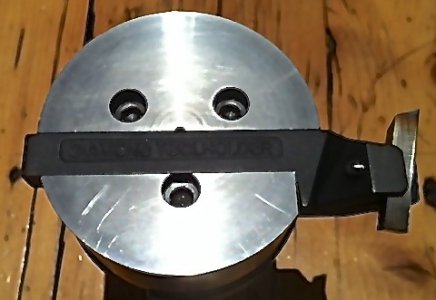- Joined
- Nov 4, 2012
- Messages
- 52
Some progress, on the proposed Flywheel Fly Cutter, thanks to input from several people.
1. Mass and Diameter nominal 6 inch cutting radius
2. Tool Holder, Square Collet style tool holder, the Collet allows the tool to be rotated within the Flywheel for the optimal cutting angle. the collet approach is what I was thinking all along but did not have the terminology to define. Now the idea have been suggested that the tool may be pushed back by the forces of the Interrupted cut. Hence the concept of the collet to hold the Tool bit.
a straight shank is simpler but a slight taper would possibly provide a more secure clamp and resist tool push back.
3. Flywheel drilled such that the Nominal Tangential Cutting angles are a result of the angle and direction of the hole drilled in the Flywheel. the collet is proposed to be clamped into the mass of the Flywheel. Please note the 12 x 12 angle is up from the horizontal not down from the vertical. I hope that makes sense. al describes this in his approach Tangential Fly-Cutter https://www.cgtk.co.uk/metalwork/sx3mill/tangentialflycutter
4. Spindle attachment to Flywheel, proposal is an R8 FMB22 Arbor, this allows the arbor to be removed from the Flywheel for storage between uses.
Now can some other voice be heard on this and I know we have people who can apply a CAD drawing to this modified concept.
It is really great working with so many wonderful people who have brought so many ideas to this concept. I certainly do not take credit for the design. my only contribution is a feeble attempt to bring the idea together where it can be built by even the novices on the forum. This last part is where the vast wisdom of the collected forum can be utilized to bring the design and machining techniques to focus on a project which enable the novices to build a usable tool with simple, tooling and the written guidance of senior members.
Stay Safe, Stay Sharp, find a fresh sheet of paper and put your thoughts on paper then, fingers to the keys for input to this collective project.
Happy New Year
1. Mass and Diameter nominal 6 inch cutting radius
2. Tool Holder, Square Collet style tool holder, the Collet allows the tool to be rotated within the Flywheel for the optimal cutting angle. the collet approach is what I was thinking all along but did not have the terminology to define. Now the idea have been suggested that the tool may be pushed back by the forces of the Interrupted cut. Hence the concept of the collet to hold the Tool bit.
a straight shank is simpler but a slight taper would possibly provide a more secure clamp and resist tool push back.
3. Flywheel drilled such that the Nominal Tangential Cutting angles are a result of the angle and direction of the hole drilled in the Flywheel. the collet is proposed to be clamped into the mass of the Flywheel. Please note the 12 x 12 angle is up from the horizontal not down from the vertical. I hope that makes sense. al describes this in his approach Tangential Fly-Cutter https://www.cgtk.co.uk/metalwork/sx3mill/tangentialflycutter
4. Spindle attachment to Flywheel, proposal is an R8 FMB22 Arbor, this allows the arbor to be removed from the Flywheel for storage between uses.
Now can some other voice be heard on this and I know we have people who can apply a CAD drawing to this modified concept.
It is really great working with so many wonderful people who have brought so many ideas to this concept. I certainly do not take credit for the design. my only contribution is a feeble attempt to bring the idea together where it can be built by even the novices on the forum. This last part is where the vast wisdom of the collected forum can be utilized to bring the design and machining techniques to focus on a project which enable the novices to build a usable tool with simple, tooling and the written guidance of senior members.
Stay Safe, Stay Sharp, find a fresh sheet of paper and put your thoughts on paper then, fingers to the keys for input to this collective project.
Happy New Year



